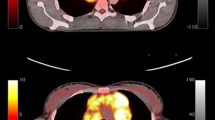Abstract
F-l 8 fluorodeoxyglucose (FDG) positron emission tomography (PET) is an excellent modality for non-invasive functional imaging of malignant lymphoma and is highly sensitive and specific for the detection of lymphoma lesions. Here, we report the findings of FDG-PET for three cases of diffuse large B cell type lymphoma (DLBCL) with extranodal tumors in the breast, stomach, and liver plus spleen, respectively. The whole body FDG-PET findings showed no evidence of lymph node (LN) involvement or distant metastasis. Strong FDG accumulations were observed in the only extranodal sites by whole body FDG-PET. Therefore, we could confirm that these cases were extranodal primary origins. Whole body PET is useful to determine the primary sites, that is, extranodal origin DLBCL with its clear images.
Similar content being viewed by others
References
Spaepen K, Stroobants S, Dupont P, Van Steenweghen S, Thomas J, Vandenberghe P, et al. Prognostic Value of Positron Emission Tomography (PET) with Fluorine-18 Fluorodeoxyglucose ([18F]FDG) After First-Line Chemotherapy in Non-Hodgkin’s Lymphoma: Is [18F]FDG-PET a Valid Alternative to Conventional Diagnostic Methods?J Clin Oncol 2001; 19: 414–419.
Dizendorf EV, Baumert BG, von Schulthess GK, Lutolf UM, Steinert HC. Impact of Whole-Body18F-FDG PET on Staging and Managing Patients for Radiation Therapy.J Nucl Med 2003; 44: 24–29.
Friedberg JW, Chengazi V. PET scans in the staging of lymphoma: current status.Oncologist 2003; 8: 438–447.
Metser U, Goor O, Lerman H, Naparstek E, Even-Sapir E. PET-CT of extranodal lymphoma.AJR 2004; 182: 1579–1586.
Moog F, Bangerter M, Diederichs CG, Guhlmann A, Merkle E, Frickhofen N, et al. Extranodal malignant lymphoma: detection with FDG PET versus CT.Radiology 1998; 206: 475–481.
Bar-Shalom R, Yefremov N, Haim N, Dann EJ, Epelbaum R, Keidar Z, et al. Camera-based FDG PET and67Ga SPECT in evaluation of lymphoma: comparative study.Radiology 2003; 227: 353–360.
Schaefer NG, Hany TF, Taverna C, Seifert B, Stumpe KD, von Schulthess GK, et al. Non-Hodgkin lymphoma and Hodgkin disease: coregistered FDG PET and CT at staging and restaging—do we need contrast-enhanced CT?Radiology 2004; 232: 823–829.
Metser U, Miller E, Kessler A, Lerman H, Lievshitz G, Oren R, et al. Solid splenic masses: evaluation with18F-FDG PET/CT.J Nucl Med 2005; 46: 52–59.
Zucca E, Roggero E, Bertoni F, Cavalli F. Primary extranodal non-Hodgkin’s lymphomas. Part 1: Gastrointestinal, cutaneous and genitourinary lymphomas.Ann Oncol 1997; 8: 727–737.
Zucca E, Roggero E, Bertoni F, Conconi A, Cavalli F. Primary extranodal non-Hodgkin’s lymphomas. Part 2: Head and neck, central nervous system and other less common sites.Ann Oncol 1999; 10: 1023–1033.
Zucca E, Cavalli F. Extranodal lymphomas.Ann Oncol 2000; 11:219–222.
Lopez-Guillermo A, Colomo L, Jimenez M, Bosch F, Villamor N, Arenillas L, et al. Diffuse large B-cell lymphoma: clinical and biological characterization and outcome according to the nodal or extranodal primary origin.J Clin Oncol 2005; 23: 2797–2804.
The International Non-Hodgkin’s Lymphoma Prognostic Factors Project. A Predictive Model for Aggressive Non-Hodgkin’ s Lymphoma.N Engl J Med 1993; 329: 987–994.
Schoder H, Noy A, Gonen M, Weng L, Green D, Erdi YE, et al. Intensity of18Fluorodeoxyglucose Uptake in Positron Emission Tomography Distinguishes between Indolent and Aggressive Non-Hodgkin’s Lymphoma.J Clin Oncol 2005; 23: 4643–4651.
The Non-Hodgkin’s Lymphoma Classification Project. A Clinical Evaluation of the International Lymphoma Study Group Classification of Non-Hodgkin’s Lymphoma.Blood 1997; 89: 3909–3918.
Ziarkiewicz-Wroblewska B, Gornicka B, Suleiman W, Wroblewski T, Morton M, Wilczynski GM, et al. Primary lymphoma of the liver—morphological and clinical analysis of 6 cases. Success of aggressive treatment.Neoplasma 2005; 52: 267–272.
Noronha V, Shaft NQ, Obando JA, Kummar S. Primary non-Hodgkin’s lymphoma of the liver.Crit Rev Oncol Hematol 2005; 53: 199–207.
Sandrasegaran K, Robinson PJ, Selby P. Staging of lymphoma in adults.Clin Radiol 1994; 49: 149–161.
Bangerter M, Moog F, Griesshammer M, Merkle E, Hafner M, Ellenrieder V, et al. Usefulness of FDG-PET in diagnosing primary lymphoma of the liver.Int J Hematol 1997; 6: 517–520.
Giardini R, Piccolo C, Rilke F. Primary non-Hodgkin’s lymphomas of the female breast.Cancer 1992; 69: 725–735.
Vignot S, Ledoussal V, Nodiot P, Bourguignat A, Janvier M, Mounier N, et al. Non-Hodgkin’s Lymphoma of the Breast: A Report of 19 Cases and a Review of the Literature.Clin Lymphoma 2005; 6: 37–42.
Topalovski M, Crisan D, Mattson JC. Lymphoma of the breast. A clinicopathologic study of primary and secondary cases.Arch Pathol Lab Med 1999; 123: 1208–1218.
Domchek SM, Hecht JL, Fleming MD, Pinkus GS, Canellos GP. Lymphomas of the breast: primary and secondary involvement.Cancer 2002; 94: 6–13.
Bakheet SM, Bakheet R, Ezzat A, Tulbah A, Durakovic A, Hussain S. F-18 FDG positron emission tomography in primary breast non-Hodgkin’s lymphoma.Clin Nucl Med 2001;26:299–301.
Kumar R, Xiu Y, Dhurairaj T, Yu JQ, Alavi A, Zhuang H. F-18 FDG positron emission tomography in non-Hodgkin lymphoma of the breast.Clin Nucl Med 2005; 30:246–248.
Kumar R, Xiu Y, Potenta S, Mavi A, Zhuang H, Yu JQ, et al.18F-FDG PET for Evaluation of the Treatment Response in Patients with Gastrointestinal Tract Lymphomas.J Nucl Med 2004; 45: 1796–1803.
d’Amore F, Brincker H, Gronbaek K, Thorling K, Pedersen M, Jensen MK. Non-Hodgkin’s lymphoma of the gastrointestinal tract: a population-based analysis of incidence, geographic distribution, clinicopathologic presentation features, and prognosis. Danish Lymphoma Study Group.J Clin Oncol 1994; 12: 1673–1684.
Cogliatti SB, Schmid U, Schumacher U, Eckert F, Hansmann ML, Hedderich J, et al. Primary B-cell gastric lymphoma: a clinicopathological study of 145 patients.Gastroenterology 1991; 101: 1159–1170.
Fleming ID, Turk PS, Murphy SB, Crist WM, Santana VM, Rao BN. Surgical implications of primary gastrointestinal lymphoma of childhood.Arch Surg 1990; 125: 252–256.
AJCC cancer staging manual. Sixth Edition. Springer, 2001 : 393–403.
Author information
Authors and Affiliations
Corresponding author
Rights and permissions
About this article
Cite this article
Nihashi, T., Hayasaka, K., Kato, R. et al. Findings of fluorine-18-FDG PET in extranodal origin lymphoma —In three cases of diffuse large B cell type lymphoma—. Ann Nucl Med 20, 689–693 (2006). https://doi.org/10.1007/BF02984681
Received:
Accepted:
Issue Date:
DOI: https://doi.org/10.1007/BF02984681




